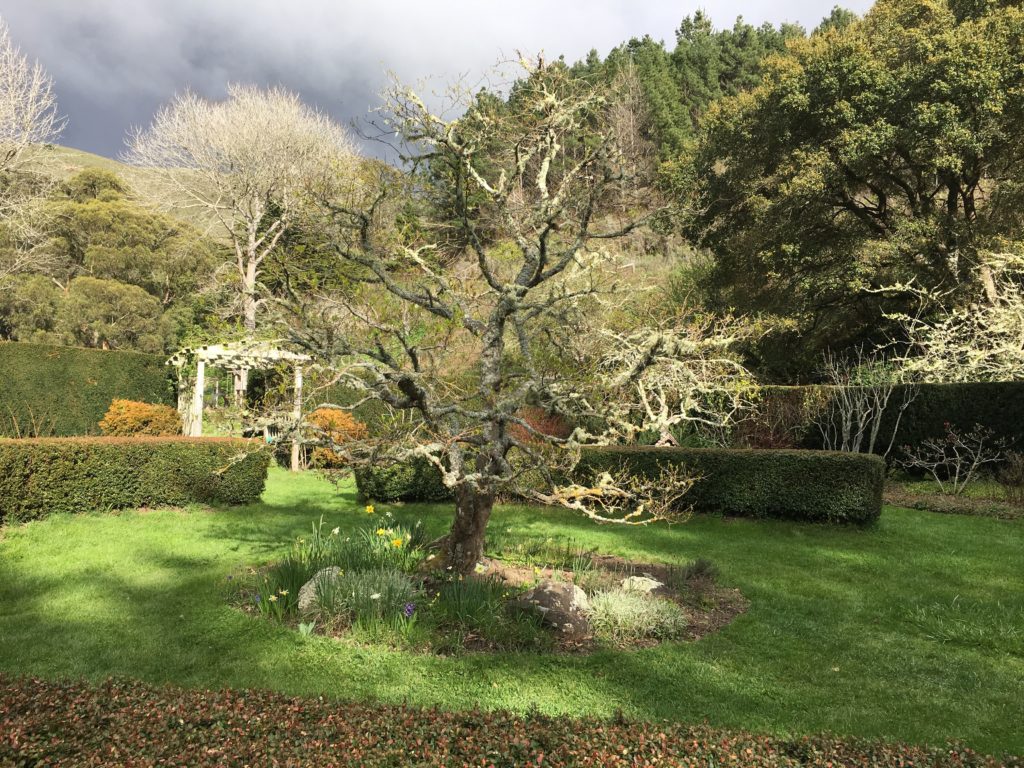
As we’ve shuddered through church shootings, school shootings, package bombs; accounts of people hiding underground for their lives in Ghouta, Syria; threats, counter-threats, and rapprochement with North Korea, this Lenten season has seemed to be headed squarely toward Holy Week all along, destined for a violent crucifixion. But it has been less obvious to me how to imagine Easter, how I would ever muster the energy and imagination for hopefulness.
Then I remembered the women at the tomb, dumbstruck to find the stone rolled away, anxious when they hear that Jesus’s body is nowhere in that tomb. Their arms still full of the soft linen cloths they have brought, water-skins, jars of myrrh for preparing the body, they stumble speechless from the tomb. What now?
The young man in the tomb points them back into the stuff of their daily lives: “He is going ahead of you to Galilee; there you will see him, just as he told you” (Mark 16:7). Go home. Open yourselves up again to the people and creatures of that place, as Jesus taught you. There you will see him.
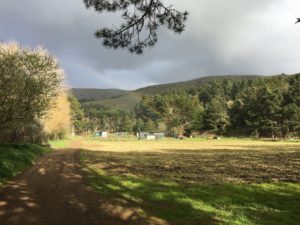 Something very odd happened to my son and me last week when we were hiking in Marin County, north of San Francisco where he lives. We had hiked the cataract trail on Mount Tamalpais until the late afternoon, then stopped for a snack to tide us over until dinner. The place we stopped was next door to Green Gulch Zen Center, which has a public path connecting to the Pacific Coast Trail. I had been curious about Green Gulch for years, as my all-time favorite gardening book was written by their head gardener, Wendy Johnson.
Something very odd happened to my son and me last week when we were hiking in Marin County, north of San Francisco where he lives. We had hiked the cataract trail on Mount Tamalpais until the late afternoon, then stopped for a snack to tide us over until dinner. The place we stopped was next door to Green Gulch Zen Center, which has a public path connecting to the Pacific Coast Trail. I had been curious about Green Gulch for years, as my all-time favorite gardening book was written by their head gardener, Wendy Johnson.
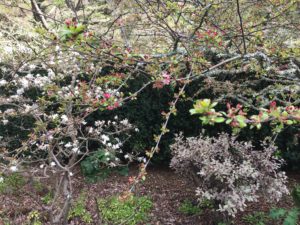 As we walked in along the path, we noticed that we were headed directly toward a bank of very dark clouds, moving toward us. We only hoped we would get a glimpse of the vegetable gardens before getting drenched. To our right, walking slowly down from the coastal trail, was a woman in a long blue skirt with a bright red shawl and a hat tied tightly down around her face. She was walking steadily, but extremely slowly. I took her to be engaged in some kind of meditative experience, so I ignored her.
As we walked in along the path, we noticed that we were headed directly toward a bank of very dark clouds, moving toward us. We only hoped we would get a glimpse of the vegetable gardens before getting drenched. To our right, walking slowly down from the coastal trail, was a woman in a long blue skirt with a bright red shawl and a hat tied tightly down around her face. She was walking steadily, but extremely slowly. I took her to be engaged in some kind of meditative experience, so I ignored her.
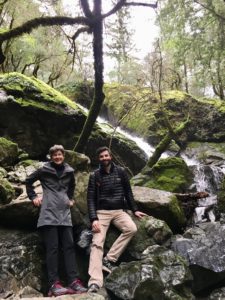 Just as my son and I came to the vegetable gardens, we decided that the threat of the storm was imminent enough that we should turn back. As we turned, we passed the strange woman again. Just as we came opposite her, she said, “There’s an English garden up there. You might not want to miss it.” I looked underneath her hat, into her face, and saw that she was younger than I expected, smiling at us in welcome. We looked back at the clouds, looked at each other, and decided to chance it.
Just as my son and I came to the vegetable gardens, we decided that the threat of the storm was imminent enough that we should turn back. As we turned, we passed the strange woman again. Just as we came opposite her, she said, “There’s an English garden up there. You might not want to miss it.” I looked underneath her hat, into her face, and saw that she was younger than I expected, smiling at us in welcome. We looked back at the clouds, looked at each other, and decided to chance it.
The garden was a large square, edged in a dense hedge so that you couldn’t see into it until you walked through a passage cut into the bushes. When we did, it took our breath away, but not because of a profusion of blooms, since it is still very early spring now along the coast. In the center of the garden stood a tall, ancient-seeming fruit tree, covered with pale yellow lichen on its twisting, spreading gray limbs. At its base were a few early daffodils and grape hyacinth, but it was this wise sentinel of a tree that riveted us. The whole garden was simultaneously a place of stability and of growth about to burst forth. It fairly hummed with contained life thrumming from the tilled flowerbeds waiting for spring. We stood stock still, until my son whispered, “I think we’d better sit down.” We sat on a bench in complete attention until we had taken the garden into ourselves, and then we started back out through the entranceway.
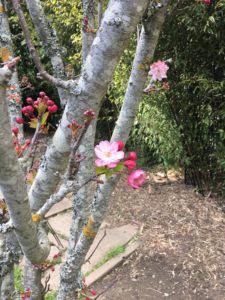 Just then, a chest-high Great Blue Heron walked slowly past, her attentive, halting gait strangely evocative of the woman who had met us on the path. Surely enough, as we walked away the rain caught up with us. We sheltered under some pines until it passed. Peering out from the boughs, we saw a rainbow stretched out over the way we had come.
Just then, a chest-high Great Blue Heron walked slowly past, her attentive, halting gait strangely evocative of the woman who had met us on the path. Surely enough, as we walked away the rain caught up with us. We sheltered under some pines until it passed. Peering out from the boughs, we saw a rainbow stretched out over the way we had come.
I don’t know what any of this means. I only know that the experience of the garden shifted something in me. It pulled me from the violence of the headlines into something still larger, older, deeply rooted, and also brand new. It pointed me back home to the people and creatures of the place I inhabit, the place where the risen Christ finds and leads me. And then it opened my swollen throat with the syllables of witness: Alleluia.
How will you recognize the resurrection?
Where does Christ find you?
What is your witness?
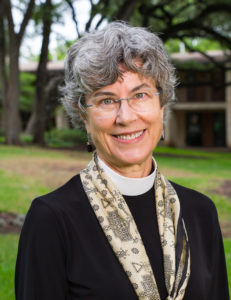 The Rev. Jane Patterson is Associate Professor of New Testament and serves as Director of Community Care. She joined the full-time faculty in 2013 after teaching part-time and serving as Interim Director of Theological Field Education 2003-2005. She is the author of Keeping the Feast: Metaphors of Sacrifice in 1 Corinthians and Philippians (SBL Press, 2015). In biblical studies her academic interests include the intersection of literary, political, and theological study of the scriptures. She also teaches in the area of Christian formation, where her work focuses on vocation and Christian practice. She serves as Co-Director of St.Benedict’s Workshop, a ministry devoted to helping laity live their faith in daily life, and serves the Diocese of West Texas as Missioner for Adult Formation and as a member of the diocesan Examining Chaplains. She is active as a preacher, teacher, and parishioner at St. Mark’s Episcopal Church in San Antonio.
The Rev. Jane Patterson is Associate Professor of New Testament and serves as Director of Community Care. She joined the full-time faculty in 2013 after teaching part-time and serving as Interim Director of Theological Field Education 2003-2005. She is the author of Keeping the Feast: Metaphors of Sacrifice in 1 Corinthians and Philippians (SBL Press, 2015). In biblical studies her academic interests include the intersection of literary, political, and theological study of the scriptures. She also teaches in the area of Christian formation, where her work focuses on vocation and Christian practice. She serves as Co-Director of St.Benedict’s Workshop, a ministry devoted to helping laity live their faith in daily life, and serves the Diocese of West Texas as Missioner for Adult Formation and as a member of the diocesan Examining Chaplains. She is active as a preacher, teacher, and parishioner at St. Mark’s Episcopal Church in San Antonio.
BA, Smith College
MTS, Perkins School of Theology
CITS, Episcopal Theological Seminary of the Southwest
PhD, Southern Methodist University

